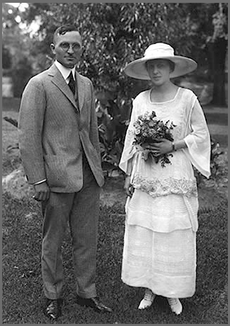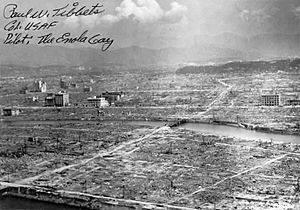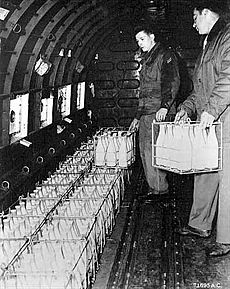Harry S. Truman facts for kids
Quick facts for kids
Harry S. Truman
|
|
|---|---|
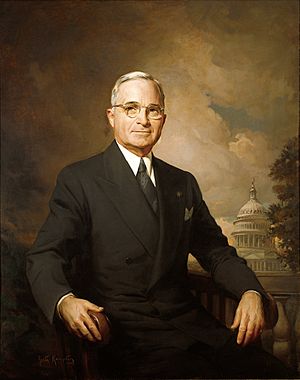
Presidential Portrait of Harry Truman, painted by Greta Kempton
|
|
| 33rd President of the United States | |
| In office April 12, 1945 – January 20, 1953 |
|
| Vice President | none (1945–1949), Alben W. Barkley (1949–1953) |
| Preceded by | Franklin D. Roosevelt |
| Succeeded by | Dwight D. Eisenhower |
| 34th Vice President of the United States | |
| In office 20 January 1945 – 12 April 1945 |
|
| President | Franklin D. Roosevelt |
| Preceded by | Henry A. Wallace |
| Succeeded by | Alben W. Barkley |
| United States Senator from Missouri |
|
| In office January 3, 1935 – January 17, 1945 |
|
| Preceded by | Roscoe Patterson |
| Succeeded by | Frank Briggs |
| Personal details | |
| Born | May 8, 1884 Lamar, Missouri |
| Died | December 26, 1972 (aged 88) Kansas City, Missouri |
| Nationality | American |
| Political party | Democratic |
| Spouse | |
| Military service | |
| Rank | major, colonel (reserve) |
Harry S. Truman (born May 8, 1884 – died December 26, 1972) was the 33rd President of the United States. He served from 1945 to 1953. He became president when President Franklin D. Roosevelt passed away while in office.
As president, Truman made big decisions about how the U.S. dealt with other countries (called foreign policy). He decided to use atomic bombs on Japan to end World War II. He also helped rebuild Europe after the war with the Marshall Plan. Truman's time as president also saw the start of the Cold War and the U.S. getting involved in the Korean War.
Contents
Early Life and Military Service
Harry S. Truman was born on May 8, 1884, in Lamar, Missouri. The letter S in his name doesn't stand for a specific middle name. It was a tribute to both of his grandfathers, whose names started with S.
He grew up in Independence, Missouri. For 12 years, he worked as a farmer in Missouri.
In 1917, Truman joined the U.S. Military. He went to France during World War I. He became a captain in the Field Artillery, which uses large guns.
Truman left the military in 1919. That same year, he married Elizabeth Virginia Wallace. He then opened a clothing store in Kansas City, Missouri.
On February 17, 1924, Harry and Bess had a daughter named Mary Margaret Truman.
Starting in Politics
Truman was active in the Democratic Party. In 1922, he was elected as a judge for Jackson County, Missouri. This job was more like a county commissioner, helping to manage the county's business.
He lost the next election for county judge but was elected again in 1926.
In 1934, Truman was elected as a Senator for Missouri. As a senator, he worked on committees. One important role was being vice-chairman of a group looking into railroad safety.
In 1940, Truman ran to be re-elected as Senator. He had to win a "primary election" first. This is where people from the same party vote to choose their best candidate. Many people thought he would lose, but he won by about 8,000 votes. He then won the main election in November.
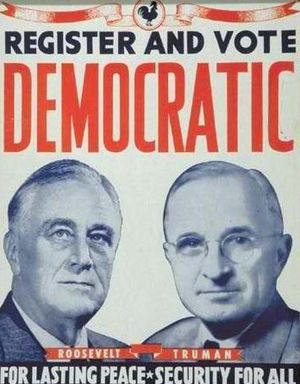
During World War II, Truman became famous for leading a committee. This group looked at how the U.S. government was spending money on defense. He found billions of dollars that he believed were wasted. Truman wanted the government to be more efficient.
In 1944, President Franklin D. Roosevelt ran for re-election. Roosevelt's health was not good. The Democratic Party knew that whoever became Vice President might soon become president.
Roosevelt chose Truman as his Vice President. They won the election. On April 12, 1945, shortly after starting his fourth term, President Roosevelt died. Harry Truman then became president.
Truman's Presidency
When Truman became president, he said it felt like "the moon, the stars, and all of the planets had fallen upon me." He became president during the final months of World War II. As Vice President, he hadn't been told much about the war. This was because the Vice President's job wasn't seen as very important back then. So, Truman became president knowing little more than the average person about the war.
Less than a month after Truman became president, Nazi Germany surrendered. This ended the war in Europe. However, Japan kept fighting. The Allies of World War II warned Japan to surrender or face "prompt and utter destruction." Japan did not surrender.
So, Truman ordered the first atomic bomb to be dropped on Hiroshima, Japan, on August 6, 1945. Three days later, a second atomic bomb was dropped on Nagasaki, Japan. Japan then surrendered, and the war ended.
The atomic bombs destroyed both cities and killed over 100,000 people. Many more died later from radiation sickness. Some people, like General Dwight D. Eisenhower, thought it was a cruel attack because Japan was already close to being defeated. Others believed it was a good decision because it ended the war quickly. Truman thought that if the U.S. had invaded Japan instead, many more American soldiers would have died.
After World War II
After the war, Truman started the Marshall Plan to help rebuild Europe, which was badly damaged. Germany was divided into two parts. The Soviet Union controlled East Germany, while the United States, Britain, and France controlled West Germany. When the Soviet Union blocked West Berlin, Truman ordered the Berlin Airlift. Airplanes flew in tons of food to feed the people in West Berlin.
Truman also helped create the United Nations. This organization helps countries work together for peace and to solve global problems. It still exists today.
After World War II, the Soviet Union and the United States became the two most powerful countries. They started the Cold War. This was not a direct fighting war. Instead, both countries tried to spread their influence around the world. The Soviet Union wanted to spread communism, which is a belief that the government should control the economy to make everyone equal. Truman believed in "containment." This meant the U.S. should stop communism from spreading. Truman announced the Truman Doctrine, which gave money to countries like Turkey and Greece to help them fight off communism.
Truman also proposed his "Fair Deal." This plan was similar to Roosevelt's "New Deal." It aimed to provide more money for education, help farmers, and raise the minimum wage for workers.
When coal miners went on strike, Truman had the government take over the mines. He generally supported workers. However, when a huge railroad strike happened, he thought it was wrong. He even threatened to make the strikers join the army if they didn't go back to work.
Truman also made an important change by de-segregating the military. This meant black and white soldiers could serve together.
In 1948, Truman ran for a second term as President against Thomas E. Dewey. Most people thought Truman would lose. The Chicago Tribune even printed a newspaper with the headline "Dewey Defeats Truman" before all the votes were counted! But to everyone's surprise, Harry Truman won the election.
The Korean War
On June 25, 1950, North Korea attacked South Korea. China supported North Korea. North Korea wanted to spread Communism into South Korea.
The U.S. fought in the Korean War to defend South Korea and stop communism from spreading there. General Douglas MacArthur wanted to bomb China. Truman thought this was too dangerous and could start a bigger war, so he fired MacArthur. Many people were angry at Truman for this because MacArthur was very respected. Truman then made Mathew B. Ridgeway the new general.
Towards the end of his time as president, many people were unhappy with Truman. Thousands of Americans had died in the Korean War. There was also some corruption in his government, and some people accused his employees of being communists. He left office on January 20, 1953. The Korean War ended about six months later.
As time passed, Truman's reputation improved. Today, many historians believe Harry Truman was a great president.
Later Life
After leaving the presidency, Truman moved back to Missouri. He died on December 26, 1972, in Kansas City, Missouri. He was 88 years old. His death was caused by multiple organ failure due to pneumonia.
Related pages
Images for kids
-
Joseph Stalin, Harry S. Truman, and Winston Churchill in Potsdam, July 1945
-
Truman in the Oval Office, receiving a Hanukkah Menorah from the prime minister of Israel, David Ben-Gurion (center).
-
President Truman (left) with Governor Dewey (right) at dedication of the Idlewild Airport, meeting for the first time since nominated for President.
-
Truman was so widely expected to lose the 1948 election that the Chicago Tribune had printed papers with this erroneous headline.
-
Truman and Indian Prime Minister Jawaharlal Nehru during Nehru's visit to the United States, October 1949
-
Official portrait of President Truman by Greta Kempton, c. 1945
-
President Truman; Alabama Senator John J. Sparkman, vice presidential nominee; and Illinois Governor Adlai Stevenson, presidential nominee, in the Oval Office, 1952
-
Truman and his wife Bess attend the signing of the Medicare Bill on July 30, 1965, by President Lyndon B. Johnson
See also
 In Spanish: Harry S. Truman para niños
In Spanish: Harry S. Truman para niños


